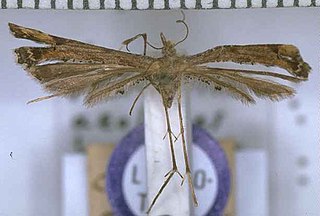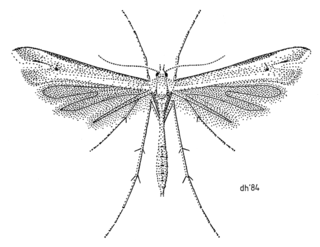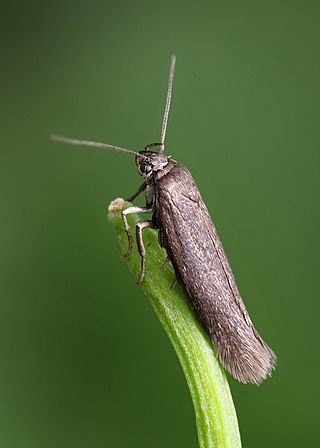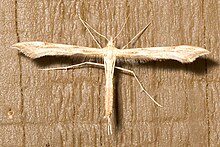
The common pug is a moth of the family Geometridae. It is a common species across the Palearctic region, including the Near East and North Africa. It ranges from the Atlantic coast of Ireland and Portugal across Europe, the Middle East and Central Asia to the Russian Far East (Priamurje) and Korea.

Cochylis nana is a moth of the family Tortricidae. It was described by Adrian Hardy Haworth in 1811. It is found in Europe, Amur Oblast of Russia and Nova Scotia in Canada.

Gillmeria ochrodactyla is a moth of the family Pterophoridae found in Asia and Europe. It was first described by the Austrian entomologists, Michael Denis & Ignaz Schiffermüller in 1775.

Ditula angustiorana, the red-barred tortrix, is a moth of the family Tortricidae found in Africa, Asia, Europe and North Africa. Other common names are the fruit-tree tortrix and the vine tortrix. The moth was first described by Adrian Hardy Haworth in 1811.

Hellinsia tephradactyla is a moth of the family Pterophoridae found in most of Europe. It was first described by the German taxonomist Jacob Hübner in 1813.

Platyptilia isodactylus is a moth of the family Pterophoridae found in China, Europe and was introduced to Australia and New Zealand for biological control. It was first described by the German entomologists, Philipp Christoph Zeller in 1852.

Amblyptilia punctidactyla, also known as the brindled plume, is a moth of the family Pterophoridae found across the Palearctic. The species was first described by the English entomologist, Adrian Hardy Haworth in 1811.

Oidaematophorus lithodactyla, also known as the dusky plume, is a moth of the family Pterophoridae found from Europe to Asia Minor and Japan. It was first described by German lepidopterist, Georg Friedrich Treitschke in 1833.

Oxyptilus parvidactyla, also known as the small plume, is a moth of the family Pterophoridae found in Africa, America latina, Asia and Europe. It was first described by Adrian Hardy Haworth in 1811.

Crombrugghia laetus, also known as the scarce light plume is a moth of the family Pterophoridae, found in southern Europe, North Africa, the Canary Islands, Asia Minor and Iraq. It was first described by the German entomologist, Philipp Christoph Zeller in 1847.

Platyptilia calodactyla is a moth of the family Pterophoridae found in Asia and Europe. It was first described by the Austrian entomologists, Michael Denis & Ignaz Schiffermüller in 1775.

Blastodacna atra, the apple pith moth, is a moth of the family Elachistidae. It is known from most of Europe and it has been introduced to North America.

Coleophora argentula is a moth of the family Coleophoridae, found in most of Europe, Russia and Asia Minor. The larvae live in cases and feed on the seeds of yarrow and sneezewort.

Amblyptilia aeolodes is a moth of the family Pterophoridae. This species was first described by Edward Meyrick in 1902. It is endemic to New Zealand and is found on the Chatham Islands, Big South Cape Island, and the subantarctic Auckland and Campbell Islands.The larvae feed on dicotyledonous herbs.

Amblyptilia epotis is a moth of the family Pterophoridae. It is endemic to New Zealand and is found in the South and Stewart Islands. It inhabits mountainous terrain covered in alpine vegetation or alternatively alpine wetland habitat. The adults of this species are on the wing from February to March. In appearance the adults of this species are variable in colour however this species can be distinguished from similar species by the oblique apical streak on its forewings as well as the patch of white on the costa cilia towards the apex of the forewing.

Amblyptilia lithoxesta is a moth of the family Pterophoridae. It is endemic to New Zealand. It was first described by Edward Meyrick in 1885. This species inhabits rough herbage on mountain sides. Larvae feed on Veronica buchananii. Adults are on the wing in January.

Epermenia falciformis, also known as the large lance-wing, is a moth of the family Epermeniidae found in Europe. It was first described by Adrian Hardy Haworth in 1828.

Aethes margaritana, the silver coast conch, is a moth of the family Tortricidae. It was described by Adrian Hardy Haworth in 1811. It is found in most of Europe. The habitat consists of downland, waste ground and shingle beaches.

Cnephasia longana, the omnivorous leaftier moth, long-winged shade or strawberry fruitworm, is a moth of the family Tortricidae. It was described by Adrian Hardy Haworth in 1811. It is native to western Europe. It is an introduced species in western North America. The species has also been reported from north-western Africa and Asia. The habitat consists of downland and rough ground.

Scythris picaepennis is a moth of the family Scythrididae first described by Adrian Hardy Haworth in 1828. It is found in Europe.





















